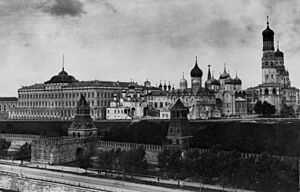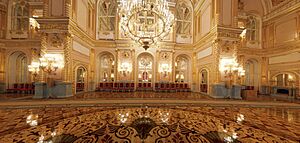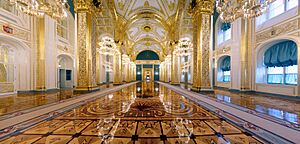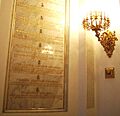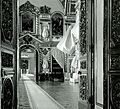Grand Kremlin Palace facts for kids
Quick facts for kids Grand Kremlin Palace |
|
|---|---|
|
Большой Кремлёвский дворец
|
|
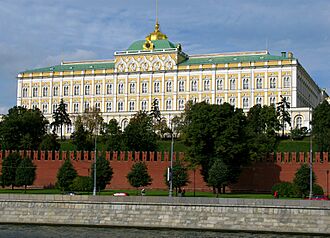
View from across the Moskva River
|
|
| General information | |
| Architectural style | Russian Revival, Byzantine Revival |
| Location | Moscow, Russia |
| Coordinates | 55°45′00″N 37°36′57″E / 55.75°N 37.6158°E |
| Construction started | 1837 |
| Completed | 1849 |
| Height | 47 metres (154 ft) |
| Technical details | |
| Floor area | 25,000 square metres (270,000 sq ft) |
The Grand Kremlin Palace (Russian: Большой Кремлёвский дворец, romanized: Bolshoy Kremlyovskiy dvorets) is a very important building inside the Moscow Kremlin in Russia. For much of the 1800s, it was the official home of the Russian emperor when he was in Moscow.
A team of architects, led by Konstantin Thon, designed this palace. Thon also designed the Kremlin Armoury and the Cathedral of Christ the Saviour. The palace was built to show how powerful the Russian rulers were. Today, the Grand Kremlin Palace is the official workplace for the president of Russia. It also has a museum that people can visit.
Contents
History of the Palace
The Grand Kremlin Palace was built between 1837 and 1849. It stands on the spot where the Grand Princes had their homes way back in the 1300s. To build this new palace, an older palace and a church were taken down.
The palace designed by Thon is 124 meters long and 47 meters high. It covers a huge area of about 25,000 square meters. The building looks like it has three floors, but it actually only has two. The top floor has two rows of windows, which makes it look taller.
The palace includes the older Terem Palace and nine churches from the 1300s, 1500s, and 1600s. It also has the Holy Vestibule and more than 700 rooms! The buildings of the palace form a rectangle with a courtyard in the middle.
The western part of the palace held grand reception halls and the emperor's private rooms. These five main halls are named after important Russian awards, called "orders." They are the Georgievsky, Vladimirsky, Aleksandrovsky, Andreyevsky, and Ekaterininsky Halls.
Today, the Georgievsky Hall is used for big state parties and official events. Important international agreements are signed in the Vladimirsky Hall. This hall also connects to other famous parts of the Kremlin, like the Palace of Facets and the Terem Palace.
During the time of the Soviet Union, the Aleksandrovsky and Andreyevsky Halls were joined together. They were used for large meetings. In the 1990s, these halls were beautifully restored to look like Thon's original designs.
Palace Design and Look
The Grand Kremlin Palace is 125 meters long and 47 meters high. Its total size is over 25,000 square meters. The palace is shaped like a square with a small courtyard in the middle. The main front of the palace faces the Moskva River.
Architect Konstantin Thon designed the palace to look like older Russian buildings. The palace has an interesting mix of styles. Its windows are framed with arches, making the building look like it has an enclosed walkway. The second level is decorated with detailed white-stone carvings. These carvings are in a Russian-Byzantine style and have double arches, which were common in Russian buildings of the 1600s.
Before 1917, the palace's front had five white-stone carvings of two-headed eagles. Above these eagles were the symbols of important Russian cities and regions. After the October Revolution, these eagles were replaced with the letters СССР (USSR) and the coat of arms of the Soviet Union. Later, the original Russian coat of arms was put back.
Inside the Palace
The palace's main entrance is not in the very center of the building. It's on the eastern side. This was done to make space for a very long grand staircase with 66 steps. This staircase is made of a special stone called Revel stone. The walls are made of artificial marble, and the columns are made of natural marble.
This grand staircase leads to the first floor, where you find a large entrance hall. From here, you can enter the grand, tall halls and ceremonial rooms. Near the main entrance on the ground floor, there's also a marble entrance area with shiny granite columns. This area also led to the private rooms of the Imperial Family.
What Happens There Now
As of 2023, the Grand Kremlin Palace is where the Russian president works. Many official events are held here. For example, the inauguration (when the president officially takes office) happens in the Hall of the Order of St. Andrew.
When there are no official events, you can take tours of the palace. You can see famous rooms like the Faceted Chamber, parts of the Teremnoy Palace, and the ceremonial halls. However, some areas, like the Catherine Palace, the Emperor's study, and the Golden Chamber of Tsaritsyno, are not part of the tour.
Inside the Grand Halls
The Hall of the Order of St. George
The Hall of the Order of St. George is the first and largest of the palace's grand rooms. It's named after the Order of St. George the Victorious, a very high military award created by Catherine the Great in 1769.
The walls of this hall are decorated with gold stars and symbols that say "For Service and Bravery." The ceiling is curved and supported by eighteen large pillars. These pillars are topped with statues that represent Russia's military victories. Marble plaques in the room list the names of military groups and individuals who received the St. George award.
This hall has been used for many important events. After World War II, soldiers gathered here for a reception after the Victory Parade. Today, it's used for giving out military awards, prizes for science and culture, and for meetings.
The Hall of the Order of St. Alexander Nevsky
This hall is named after the Order of St. Alexander Nevsky, an award created by Catherine I in 1725. It's located in the middle of the first floor on the south side of the palace. It connects to the Hall of St. George through large silver-plated doors.
The room is 31 meters long, 20 meters wide, and 20 meters high. It's decorated with the symbols of different regions of the Russian Empire. There are also wall mirrors, marble fireplaces, and fancy candle holders. The ceiling has an oval dome with images of the Order's symbols. The floor is made of thirty different types of wood!
In the 1930s, this hall was changed and became part of a larger meeting area. But in the 1990s, it was restored to its original look. Now, it's used for meetings of the State Council.
The Hall of the Order of St. Vladimir
The Hall of the Order of St. Vladimir is named after an award created by Catherine the Great in 1782. Light comes into this hall only from a skylight in the center of its dome. A large, beautiful chandelier hangs from this dome.
The room is shaped like a circle with a walkway around it. It was originally a square, but the corners have special curved areas that make it look like an octagon. The decorations match the symbols of the Order, using white, pink, and pale green colors. The walls are covered with pink and white marble. The star-shaped floor is made from more than twenty different kinds of wood.
After 1918, the Hall of the Order of St. Vladimir was used for signing agreements between the USSR and other countries.
The Hall of the Order of St. Andrew
The Hall of the Order of St. Andrew was the most important room for showing off military honors of the Russian Empire. It's named after the Order of St. Andrew, which Peter the Great started in 1698.
This hall was used for big ceremonies, including the coronations (crowning ceremonies) of emperors like Alexander II, Alexander III, and Nicholas II. Originally, the emperor's throne was the main feature of the room. Later, three seats were placed there for Emperor Nicholas II and his empresses.
After the Russian Revolution, this hall was used for important meetings of the Comintern and the Supreme Soviet of the USSR. In the 1930s, it was even combined with the Hall of St. Alexander Nevsky for these large meetings.
In 1993, Russian President Boris Yeltsin ordered the hall to be restored to its original historical look. Now, it's used for special meetings and events, including sessions of the State Council and meetings with foreign ambassadors. The inauguration of the Russian president also takes place in this hall.
The Hall of the Order of St. Catherine
The Hall of the Order of St. Catherine was the throne room for Russian empresses. It's named after the Order of Saint Catherine, an award created in 1714. The entrance has pillars decorated with beautiful malachite patterns. The walls have detailed carvings decorated with shiny rhinestones. The floor was designed by Fedor Solntsev.
In the 1900s, this hall was used for meetings of different parts of the Supreme Soviet of the USSR. During World War II, important meetings with foreign visitors were held here. Many famous people, like Chinese diplomat Soong Ziwen and General Dwight Eisenhower, attended receptions in this hall.
As of 2018, this hall is not part of the public tours. This is because it's still used by the Russian president for meetings and talks with foreign leaders.
Images for kids
-
View from the Moskva River
-
The royal coach of Nicholas II by the palace, 1896
-
Coat of arms of Russia restored to the upper arches following the dissolution of the Soviet Union


